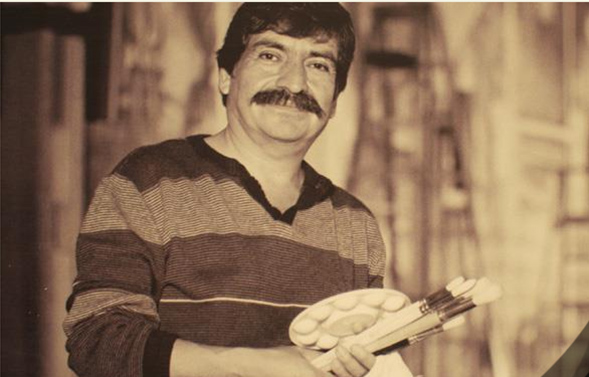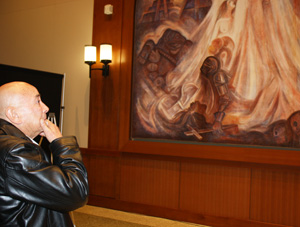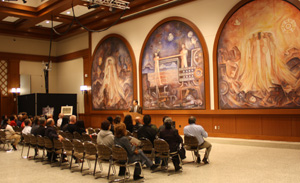A Flood of Memories
Guillermo Aranda returned to SDSU to visit the mural he helped create in the late 1960s and early 1970s.

Guillermo Aranda stood stunned into silence, the tears welling in his eyes saying everything. It had been decades since he had seen the giant triptych before him and as he tried to take it all in, the jumble of meaning, memory and emotion that swept through him was every bit as overwhelming as the scale of the images before him.
As a young man he had helped create them. As he confronted them now nearing his 70th birthday, they served as a validation not only of his work, but of who and what he is.
From 1968 to 1970 Aranda had been a studio art major at San Diego State. During those years, he and fellow artist Ruben DeAnda helped acclaimed Mexico City muralist Gilberto Ramirez paint a mural in three panels, each roughly 20 feet high and 12 feet wide, representing the evolution of the Chicano movement.

The images were painted on the wall of Montezuma Lounge in the former Aztec Center. When the building was razed, the “Mural Triptico,” as it was called, was preserved and reinstalled inside the new Montezuma Hall in the Conrad Prebys Aztec Student Union.
A new outlook
Aranda had been invited to the March 6 Mural Triptico re-dedication ceremony. He traveled from his home in Salinas to attend the event with three family members. Before anyone else arrived, he walked through the doors of Montezuma Hall and stood before the mural he and his friend had helped their mentor paint so many years ago.
“Emotions, you know?” Aranda said when asked about his response to seeing the art work so beautifully displayed. “To see it up there, you can imagine all of the memories flooding my head.”
His father and grandfather had both been artists, but Aranda said he had never considered becoming a muralist until he worked with Ramirez.
"I had never seen his approach to mural,” Aranda recalled. “The whole concept of mural was new to me.
“Prior to apprenticing with Gilberto, my concept of art was a painting that you put in the front room or an office. He changed my whole understanding of art – my whole outlook.”
Looking for direction
Over the two years they worked on the Mural Triptico, Ramirez both instructed and inspired DeAnda and Aranda.
"Gilberto was quite proficient at what he was doing and for me it was a whole new experience,” Aranda said. “The technique he used of washes and glazing was all really new, so I always felt kind of lost, in a way, and kind of always looking for his direction as to what needed to be done.
“I made every effort to come down here and work with him between classes and sometimes skipped classes because I got so involved in what I was doing. He was here when I got here each day and he was still here as I was leaving.”
The piece the three artists completed represents an important part of San Diego’s cultural history. As the Mural Triptico was being created, so was Chicano Park and the Centro Cultural de la Raza in Balboa Park was also being established.

Overdue recognition
"San Diego was like the hub of the mural movement during the civil rights movement and the Chicano art that took place here,” Aranda said. “When we finished here I went to Mexico. I had to see all of these things that Gilberto was telling me about and I was down there for close to a month just going from city to city looking at (different art) works.
“Within a couple of years we initiated the murals at Chicano Park, but I think from that point on it just continued to spread. San Diego was like the starting point of that seed that got planted here."
In addition to San Diego, Aranda’s murals can be seen throughout California in places like the student center at CSU Monterey Bay, Watsonville and throughout the Salinas area where he works with young people in after-school and parks and recreation programs. He tries to instruct and inspire them as he was instructed and inspired by Ramirez.
"It's nice to see it up,” he said of the Mural Triptico that altered his view of art. “I'm really happy that Gilberto is getting the recognition that I feel he deserves. For me that acknowledgement has been long overdue.
“Muralism changed my life. I'm still a muralist. I continue to paint. It gave my life a different direction."



